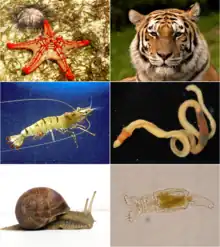Nephrozoa
Nephrozoa is a major clade of bilaterians, divided into the protostomes and the deuterostomes, containing almost all animal phyla and over a million extant species. Its sister clade is the Xenacoelomorpha. The Ambulacraria (conventionally deuterostomes) are occasionally thought to be sister to the Xenacoelomorpha, forming the Xenambulacraria as basal Deuterostomia, or basal Bilateria invalidating Nephrozoa and Deuterostomia in multiple studies.[1][2][3][4][5] The coelom, the digestive tract and excretory organs (nephridia), and nerve cords developed in the Nephrozoa.[6] It has been argued that, because protonephridia are only found in protostomes, they cannot be considered a synapomorphy of this group. This would make Nephrozoa an improper name, leaving Eubilateria as this clade's name.[7]
| Nephrozoa | |
|---|---|
 | |
| Scientific classification | |
| Domain: | Eukaryota |
| Kingdom: | Animalia |
| Subkingdom: | Eumetazoa |
| Clade: | ParaHoxozoa |
| Clade: | Bilateria |
| Clade: | Nephrozoa Jondelius et al. , 2002 |
| Phyla | |
| |
| Synonyms | |
|
Eubilateria Peter Ax, 1987 | |
Chordates (which include all the vertebrates) are deuterostomes.[8] It seems very likely that the 555 million year old Kimberella was a protostome.[9][10] If so, this means that the protostome and deuterostome lineages must have split sometime before Kimberella appeared — at least 558 million years ago, and hence well before the start of the Cambrian 538.8 million years ago.[8]
| Bilateria |
| ||||||||||||||||||||||||||||||
References
- Philippe, Hervé; Poustka, Albert J.; Chiodin, Marta; Hoff, Katharina J.; Dessimoz, Christophe; Tomiczek, Bartlomiej; Schiffer, Philipp H.; et al. (2019). "Mitigating Anticipated Effects of Systematic Errors Supports Sister-Group Relationship between Xenacoelomorpha and Ambulacraria". Current Biology. 29 (11): 1818–1826.e6. doi:10.1016/j.cub.2019.04.009. hdl:21.11116/0000-0004-DC4B-1. ISSN 0960-9822. PMID 31104936. S2CID 155104811.
- Marlétaz, Ferdinand (2019-06-17). "Zoology: Worming into the Origin of Bilaterians". Current Biology. 29 (12): R577–R579. doi:10.1016/j.cub.2019.05.006. ISSN 0960-9822. PMID 31211978.
- Kapli, Paschalia; Telford, Maximilian J. (11 Dec 2020). "Topology-dependent asymmetry in systematic errors affects phylogenetic placement of Ctenophora and Xenacoelomorpha". Science Advances. 6 (10): eabc5162. doi:10.1126/sciadv.abc5162. PMC 7732190. PMID 33310849.
- Kapli, Paschalia; Natsidis, Paschalis; Leite, Daniel J.; Fursman, Maximilian; Jeffrie, Nadia; Rahman, Imran A.; Philippe, Hervé; Copley, Richard R.; Telford, Maximilian J. (2021-03-19). "Lack of support for Deuterostomia prompts reinterpretation of the first Bilateria". Science Advances. 7 (12): eabe2741. Bibcode:2021SciA....7.2741K. doi:10.1126/sciadv.abe2741. ISSN 2375-2548. PMC 7978419. PMID 33741592.
- Marlétaz, Ferdinand; Peijnenburg, Katja T.C.A.; Goto, Taichiro; Satoh, Noriyuki; Rokhsar, Daniel S. (2019-01-21). "A New Spiralian Phylogeny Places the Enigmatic Arrow Worms among Gnathiferans". Current Biology. 29 (2): 312–318.e3. doi:10.1016/j.cub.2018.11.042. PMID 30639106.
- Cannon, Johanna Taylor; Vellutini, Bruno Cossermelli; Smith, Julian; Ronquist, Fredrik; Jondelius, Ulf; Hejnol, Andreas (2016). "Xenacoelomorpha is the sister group to Nephrozoa". Nature. 530 (7588): 89–93. Bibcode:2016Natur.530...89C. doi:10.1038/nature16520. PMID 26842059. S2CID 205247296.
- "Animal Evolution: Interrelationships of the Living Phyla. Third Edition. By Claus Nielsen. Oxford and New York: Oxford University Press ISBN: 978-0-19-960602-3 (hc); 978-0-19-960603-0 (pb). 2012". The Quarterly Review of Biology. 87 (3): 258. September 2012. doi:10.1086/666815. ISSN 0033-5770.
- Erwin, Douglas H.; Eric H. Davidson (1 July 2002). "The last common bilaterian ancestor". Development. 129 (13): 3021–3032. doi:10.1242/dev.129.13.3021. PMID 12070079.
- Fedonkin, M.A.; Simonetta, A; Ivantsov, A.Y. (2007), "New data on Kimberella, the Vendian mollusc-like organism (White sea region, Russia): palaeoecological and evolutionary implications", in Vickers-Rich, Patricia; Komarower, Patricia (eds.), The Rise and Fall of the Ediacaran Biota, Special publications, vol. 286, London: Geological Society, pp. 157–179, doi:10.1144/SP286.12, ISBN 978-1-86239-233-5, OCLC 156823511
- Butterfield, N.J. (December 2006). "Hooking some stem-group "worms": fossil lophotrochozoans in the Burgess Shale". BioEssays. 28 (12): 1161–6. doi:10.1002/bies.20507. PMID 17120226. S2CID 29130876.
Further reading
- Balavoine, G. (17 April 1998). "EVOLUTION: One or Three Cambrian Radiations?". Science. 280 (5362): 397–398. doi:10.1126/science.280.5362.397. ISSN 0036-8075. S2CID 84468701.
- Bourlat, S; Nielsen, C; Economou, A; Telford, M (October 2008). "Testing the new animal phylogeny: A phylum level molecular analysis of the animal kingdom". Molecular Phylogenetics and Evolution. 49 (1): 23–31. doi:10.1016/j.ympev.2008.07.008. ISSN 1055-7903. PMID 18692145.
- Jondelius, Ulf; Ruiz-Trillo, Inaki; Baguna, Jaume; Riutort, Marta (April 2002). "The Nemertodermatida are basal bilaterians and not members of the Platyhelminthes". Zoologica Scripta. 31 (2): 201–215. doi:10.1046/j.1463-6409.2002.00090.x. ISSN 0300-3256. S2CID 84015834.
External links
 Data related to Nephrozoa at Wikispecies
Data related to Nephrozoa at Wikispecies
_001.png.webp)